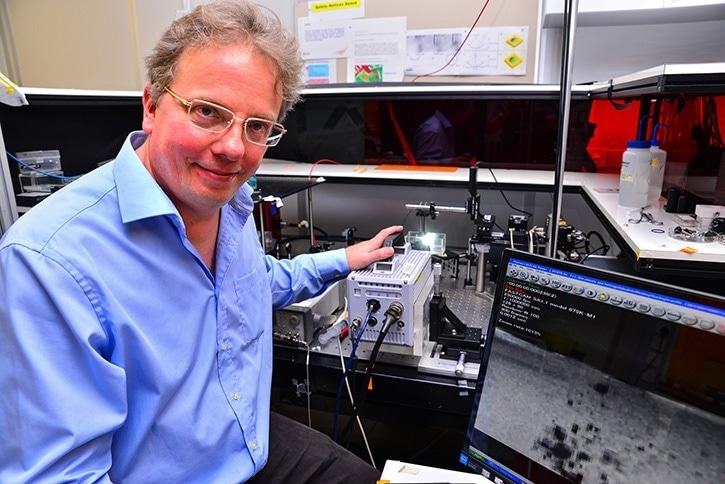Dec 7 2016
A new ultrasound device for producing sharper images through 3D printed lenses has been developed by scientists from Nanyang Technological University, Singapore (NTU Singapore).
 NTU Singapore scientist Assoc Prof Claus-Dieter Ohl developed a new ultrasound device that will allow for more accurate medical procedures that involve the use of ultrasound to kill tumours, loosen blood clots and deliver drugs into targeted cells. Credit: Nanyang Technological University
NTU Singapore scientist Assoc Prof Claus-Dieter Ohl developed a new ultrasound device that will allow for more accurate medical procedures that involve the use of ultrasound to kill tumours, loosen blood clots and deliver drugs into targeted cells. Credit: Nanyang Technological University
This new device will enable surgeons and doctors to have clearer images when performing non-invasive diagnostic procedures and medical surgeries.
It will also allow for more precise medical procedures involving the use of ultrasound to kill tumors, deliver drugs into targeted cells and loosen blood clots.
This device is equipped with high quality lenses that have been 3D printed.
In the existing ultrasound machines, the lenses focusing the ultrasound waves are limited to spherical and cylindrical shapes, limiting the clarity of the imaging.
It is possible to make complex lens shapes resulting in sharper image with the help of 3D printing. The 3D printed lenses allow focusing of ultrasound waves on multiple sites or shape the focus particularly to a target, which cannot be performed by existing focus.
Industry partners keen to develop commercial applications
The unique ultrasound device was developed by a multidisciplinary team of scientists, headed by Associate Professor Claus-Dieter Ohl from NTU’s School of Physical and Mathematical Sciences.
The findings obtained through rigorous testing of the ultrasound device have been featured in Applied Physics Letters, a peer-reviewed journal by a leading global scientific institute – the American Institute of Physics.
With this advancement, the NTU team is currently in talks with a wide range of healthcare and industry partners who aim at developing prototypes for research and medical applications.
In most medical surgeries, precision and non-invasive diagnosis methods are crucial. This novel device not only determines the focus of the wave but also its shape, granting greater accuracy and control to medical practitioners.
Claus-Dieter Ohl, Associate Professor
Overcoming current limitations
High-frequency vibrations are developed by producing ultrasound waves by firing sound waves at a glass surface or ‘lens’.
In standard ultrasound machines, the resulting heat causes rapid expansion of the lens, thus producing high frequency vibrations that develop ultrasound waves.
The new ultrasound device with 3D printed lenses overcomes the limitations of glass. Complex and customized 3D printed lenses can be produced from varied targets resulting in enhanced imaging, and are also easier and cheaper to produce.
3D printing reinvents the manufacturing process, enabling the creation of unique and complex devices. In turn, the way medical devices are created needs to be rethought. This is an exciting discovery for the scientific community as it opens new doors for research and medical surgery.
Claus-Dieter Ohl, Associate Professor
This new invention taps into an ultrasound market, which is expected to grow to almost US$ 6.9 billion by 2020. This breakthrough is also expected to make way for new research opportunities and medical techniques in health sciences such as surgery, and biotechnology.
For instance, researchers could make use of the sound waves for measuring elastic properties of cells in a petri dish, observing how they respond to forces. This indeed will be useful for distinguishing between benign and harmful tumor cells.
This is a very promising breakthrough, potentially offering significant clinical benefits including to the field of cancer imaging. This technology has the potential to reduce image distortions and more accurately differentiate cancerous from non-cancerous soft tissue.
Tan Cher Heng, Adjunct Assistant Professor, LKCMedicine Lead for Anatomy & Radiology and Senior Consultant with the Department of Diagnostic Radiology at Tan Tock Seng Hospital.